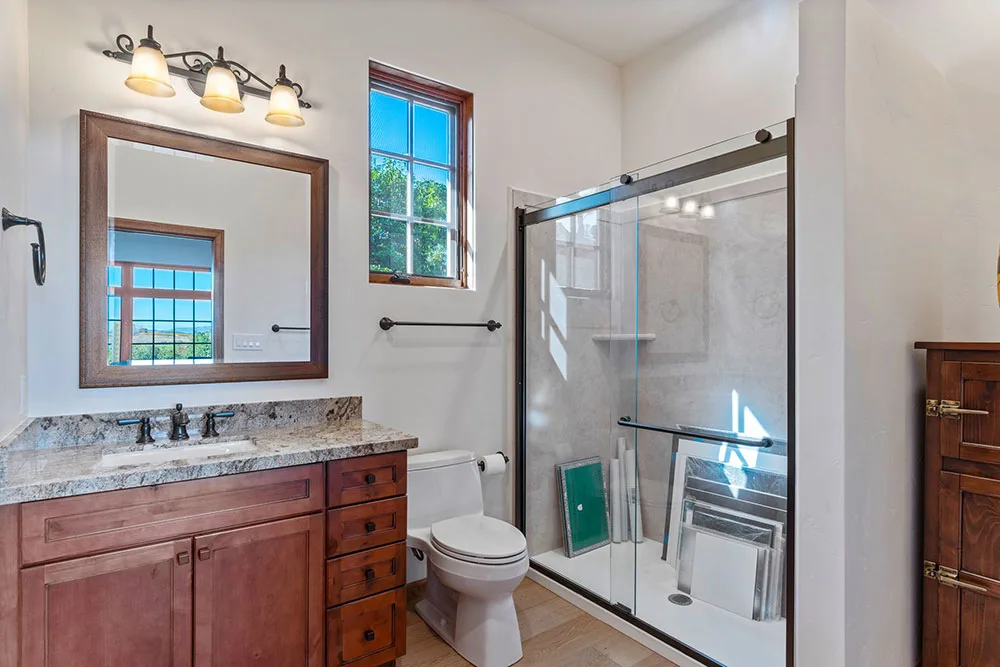2025 Bathroom Accessibility Upgrades: Age-in-Place Remodeling Solutions

Summary
- An accessible bathroom remodel enhances safety, comfort, independence, and property value for elderly adults, people with disabilities, and multi-generational families.
- Bathrooms are high-risk areas, and accessibility upgrades reduce accidents and improve usability.
- Key accessibility features include walk-in tubs and curb-free showers, non-slip flooring, grab bars and support rails, smart toilets and bidet attachments, adjustable vanities and sinks, and voice-activated lighting and faucets.
Table of Contents
Introduction
As more homeowners choose to remain in their homes long-term, age-in-place bathroom remodeling is becoming a top priority in home remodeling and design. An accessible bathroom remodel not only improves safety for children and older adults but also enhances comfort and property value.
From walk-in tubs and voice-activated features to adjustable vanities, there’s no limit to the best bathroom accessibility upgrades you can choose in 2025. The goal is to create a luxurious space that adapts to your needs as you grow, minimizing the need for costly or exhaustive upgrades later in the future.
Why Accessibility is Key in Bathroom Design
The bathroom is one of the most frequently used and dangerous places in the home. For older adults, individuals with disabilities, children, and anyone hoping to age in place, traditional bathroom layouts can pose serious safety and usability challenges. Here is how accessible bathroom design ideas can help:
- Safety : With the addition of non-slip flooring and grab bars, accessible bathroom design improves the functionality and safety of your bathroom. A walk-in shower also removes the need to step over a high threshold or step down, which can easily lead to accidents.
- Independence : Key features such as comfort-height toilets and showerheads allow for greater control and independence in your daily routines.
- Future-Proofing : Accessible features ensure that your bathroom remains functional, comfortable, and adaptable to your needs as you age.
- Increases Property Value: Homes with accessible bathroom designs are a valuable investment, appealing to a wide range of buyers, especially older individuals and those with disabilities.\
Top Bathroom Accessibility Upgrades in 2025
The most popular accessible bathroom remodel design focuses on design, independence, and ease of use. Here are the top upgrades to consider:
1. Walk-In Tubs & Curb-Free Showers
Walk-in tubs and curb-free showers eliminate edges, making it easy for you to access your bathroom without having to lift your legs over slick edges. These designs create a seamless transition that accommodates people with limited mobility and wheelchair users.
Curb-free showers pair nicely with waterproof flooring and wall-to-wall tiling. Handheld showers with built-in seating also make it easier to bathe while seated, providing direct control over water pressure and flow.
2. Non-Slip Flooring Options
Bathroom floors are susceptible to water slips, making them risky for people of all ages. Therefore, installing non-slip flooring is a crucial solution for aging-in-place bathroom remodeling.
Popular non-slip flooring options for ADA bathrooms include:
- Rubber: Rubber flooring remains comfortable underfoot and provides a firm grip. Additionally, this option offers the best protection against injuries resulting from falls.
- Slip-resistant Vinyl: This type of flooring is waterproof and comes in designs that can replicate wood, stone, and other finishes.
- Textured Ceramic and Porcelain Tiles: This flooring is durable and water-resistant, featuring slip-resistant coatings to reduce the risk of falls.
Accessible materials like vinyl and ceramic tiles require low maintenance due to their waterproof qualities, which make them easy to clean without the need for scrubbing. Rubber flooring also resists water buildup and is easy to wipe down.
3. Grab Bars and Support Rails
Grab bars and support rails are essential features in an accessible bathroom remodel. Place these bars strategically around the bathroom to allow for improved mobility, not just within the shower or bathtub.
These bars must be sturdy and installed securely as they offer added balance when stepping up, stepping down, or moving across a wet surface. They also provide extra leverage when standing up or sitting down, reducing the risk of slips.
It is essential to use ADA-compliant safety standards such as:
- Securely install them at the right height
- Position them near the toilet, bathtub, and shower
- Choose bars with slip-resistant surfaces
- Integrate them into the design of your bathroom
4. Smart Toilets and Bidet Attachments
Smart toilets and bidet attachments are redefining comfort and accessibility in modern bathrooms. These high-tech fixtures offer features such as:
- Automatic lid opening and closing for hands-free use
- Remote control to prevent hand stretching or bending
- Integrated bidets with adjustable water temperature and pressure
- Heated seats to improve comfort
5. Adjustable-Height Vanities and Sinks
Vanities and sinks that adjust to the user’s height are perfect bathroom modifications for aging in place. ADA guidelines recommend that vanities and sinks be mounted no higher than 34 inches from the floor with a minimum 27-inch high knee clearance underneath. This allows wheelchairs to roll up and access the sink without causing discomfort to users.
Key features for adjustable vanities and sinks include:
- Wall-Mounted or Floating Vanities: This design provides clear space underneath.
- Touchless or Lever-Handle Faucets: This reduces the effort required for you to use the sink and vanity. It is an essential feature for those with limited hand mobility.
- Rounded Edges: This feature reduces the risk of injury in tight spaces.
- Open Cabinet Designs: This offers easier access to storage for seated users.
The right height for sinks and vanities is not just about comfort but also about enhancing your safety and independence in the bathroom.
6. Voice-Activated Lighting and Faucets
Home automation takes accessibility to the next level. Voice-activated lights and faucets are ideal for those with arthritis, limited hand strength, or vision impairment. These upgrades not only improve safety and functionality for all ages but also enhance comfort and convenience.
Read More: Sustainable Home Design Trends in San Diego – Best of 2025
Cost & ROI of Age-in-Place Bathroom Remodeling
Investing in an accessible bathroom remodel may seem like a significant decision, but in 2025, it is one of the smartest ways to future-proof your home. Age-in-place bathroom remodeling costs vary widely based on the scale of the modifications, material choices, and labor costs.
- Curb-Free Showers
Curb-free showers are a popular choice for bathroom accessibility upgrades in 2025. These showers feature low-entry designs, making them safe for individuals with mobility issues. Curb-free showers typically cost between $4,000 to $15,000.
- Grab Bars
Grab bars provide support and stability, reducing the risks of falls and injuries. They typically cost between $200 and $800 each, including installation. The total expense can increase depending on the number of items needed and their placement around your bathroom.
- Bidet attachments
Bidet attachments help aging homeowners maintain their health and independence. Depending on the model and features, they can cost between $200 and $700.
- Non-slip Flooring
Non-slip flooring is a crucial safety feature in all aging-in-place bathrooms. They typically cost $1,500-$4,000, depending on location, size of the bathroom, and type of flooring.
Return on Investment
While bathroom remodels typically offer a 60-70% return on investment (ROI), age-in-place bathroom remodeling goes beyond just the resale value.
- Increased home appeal to aging buyers and multi-generational households.
- Reduced risk of injury, helping to save thousands in medical expenses.
- Lower caregiving costs: Instead of paying for costly care at assisted living facilities, you can have your independence and dignity.
Choosing the Right Contractor for Bathroom Remodeling
When it comes to accessible bathroom designs, selecting the right contractor is just as crucial as the upgrades themselves. You want someone who understands the unique needs of elderly adults and individuals with disabilities. If you are wondering how to remodel a bathroom for accessibility, here are some things to look for:
- Certified Aging-in-Place Specialist (CAPS)
Look for contractors with CAPS certification from the National Association of the Remodeling Industry (NARI) or the National Association of Home Builders (NAHB). This indicates that they are trained to design and build environments tailored to the needs of aging homeowners.
- Experience with Accessible Bathroom Remodels
Ask for examples of past projects that included features like walk-in tubs, grab bars, non-slipping floors, or adjustable vanities. A contractor with the right experience can offer better design insights and solutions tailored to your needs, as well as help avoid common mistakes.
- Knowledge of ADA Guidelines
Standard bathrooms often fail to meet ADA guidelines, so when selecting a contractor, prioritize their familiarity with ADA standards. This ensures that you create a space that is both safe and functional.
Conclusion
Age-in-place bathroom remodeling is not just about safety but also about functionality and convenience. Popular bathroom accessibility upgrades to consider in 2025 include walk-in tubs and showers, non-slip floors, grab bars, smart toilets, adjustable vanities, and voice-activated lights.
The average accessible bathroom remodel is a worthwhile investment, as it helps save money on assisted living, minimizes the risk of injury, and grants more independence and dignity as you age. House to Home offers efficient, safe, and functional bathroom remodels customized for multi-generational households and individuals with disabilities. Explore our 2025 portfolio of bathroom accessibility upgrades.
Read more : The Role of Smart Technology in Home Remodeling
FAQs
Bathroom renovation trends in 2025 reflect a blend of high-tech and age-in-place features, including smart toilets, voice-activated lights and faucets, and curb-free bathrooms.
The cost of a bathroom remodel typically ranges between $6,000 and $15,000 for a basic upgrade and between $20,000 and $ 45,000 or more for an accessible bathroom remodel. This can vary depending on the size of the bathroom, materials used, location, and the scale of the upgrades.
In most cases, Medicare does not pay for ADA bath remodels, even if they are medically necessary. However, there are exceptions, such as Medicare Advantage (Part C), if you are a veteran or if you qualify for the Medicaid Home and Community-Based Services (HCBS) Waivers.
If your bathroom has suffered damage, Homeowners Insurance may cover restoring it to its original condition but not upgrades or aging-in-place features.
To make a bathroom accessible for individuals with disabilities, focus on improving maneuverability, safety, and ease of use. This can involve widening doorways, installing grab bars, and height-adjustable sinks, among other modifications.
A walk-in shower typically costs between $3,500 and $15,000, depending on the features, materials, and labor involved.
The cost to remodel a handicap-accessible bathroom in 2025 ranges from $15,000 to $40,000 or more, depending on the bathroom’s size, level of accessibility, materials used, and local labor rates.
ADA-compliant bathrooms require specific dimensions and features to ensure accessibility for individuals with disabilities. These include adequate space for navigation, accessible toilets, and sinks, grab bars, and appropriate door width and clearances.
The wet area, including the shower and tub, is generally the most expensive part of a bathroom remodel. This is due to the high cost of materials, such as tile, the extensive plumbing work involved, and the custom installation required. Labor costs also contribute significantly to the price.
To negotiate a bathroom remodel, obtain multiple quotes from several contractors, clearly define your needs and budget, compare quotes to identify cost-cutting measures, consider material substitutions offered by contractors, and negotiate payment terms.
About Author

Founder & Chief Sales Officer, House to Home
John Hayes is the Founder and Chief Sales Officer of House to Home Design Build Remodel, a leading general contracting firm serving homeowners across North County San Diego.
